Guest Michelle Scheuermann regales us with her tale of a recent adventure she and a friend took — the South Dakota Kayak Challenge. If you’ve ever thought of entering a race such as this one, read this account first.
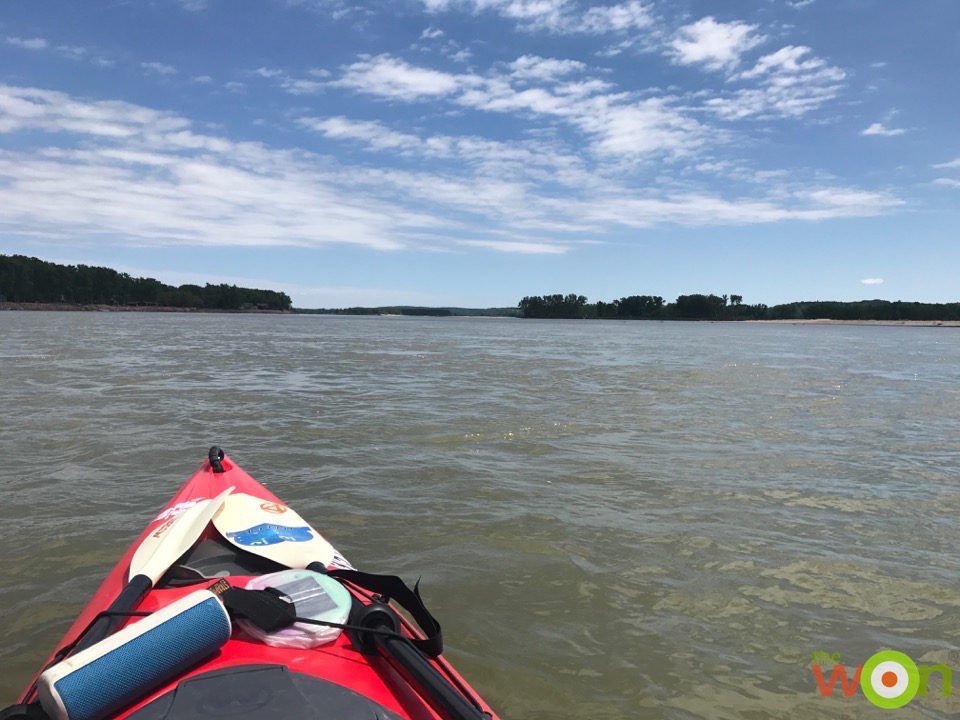
Want to take your kayaking adventures up a notch? How about a race? How about a 72-mile river race on one of the largest rivers in North America? The South Dakota Kayak Challenge has been held every Memorial Day Weekend in southeastern South Dakota for the past 7 years. Beginning in Yankton, South Dakota, and ending in South Sioux City, Iowa, the race covers 3 states (throw in Nebraska) and 72 river miles over 4 checkpoints. This part of the river is part of the National Park Service’s (NPS) Missouri National Recreational River, a unique waterway is the only NPS property that holds the designations of Wild and Scenic River, National Park and National Water Trail.
My adventure buddy, Cassie, and I first discovered this race a few years back at Canoacopia in Madison, Wisconsin. Signing up for the race made it easier knowing I had support (my mom) in the area and frankly, Cassie and I wanted to test ourselves!
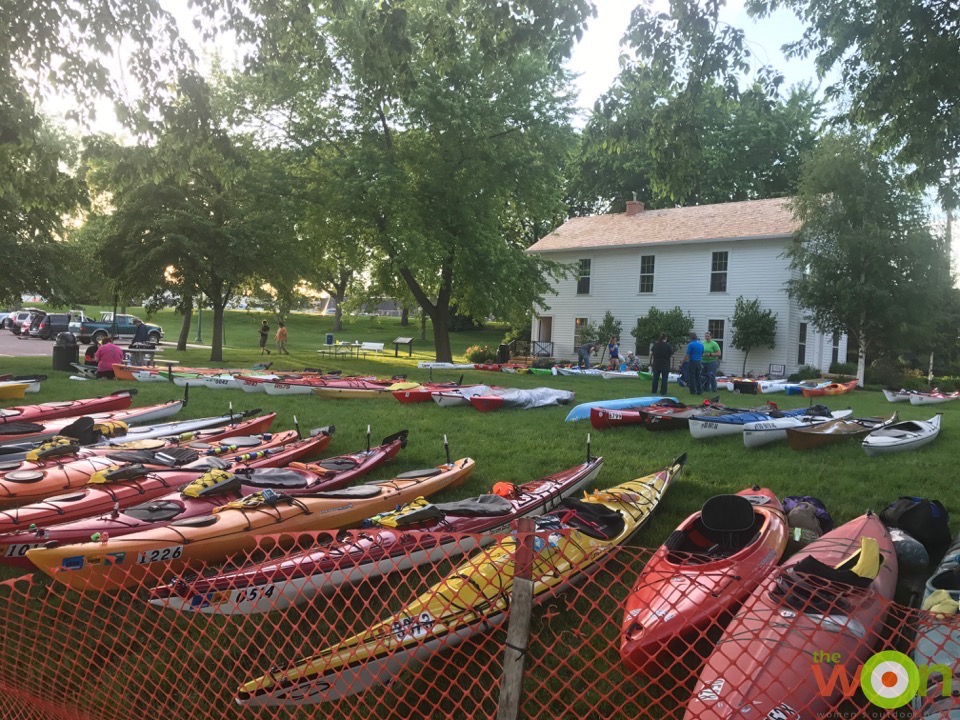
The kayak corral.
Register
We sent in our $50 registration fee (cheap!) and then completely forgot about it until practically the week of the race. How DO you prepare for a 72-mile kayak race? I asked the organizers – who are wonderful folks – and they pointed me to a few Facebook groups and pages, but nothing that was a definitive plan of “this is how you paddle 72 river miles.” So … we prepared for it like we would a running race – by bringing lots of fuel (good balance of carbs, sugar and protein) and water with electrolytes. We knew that many river miles would mean being on the water a minimum of 10 hours, but probably even longer.
Get there
We drove to Yankton on Friday of Memorial Day weekend to arrive by mid-afternoon. After unloading our kayaks and gear, we drove to South Sioux City, Iowa, to drop off our vehicles, which was a good hour and half drive – on an interstate with an 80 mile-per-hour speed limit. That gives you a good indication of how far we had to travel the following day.
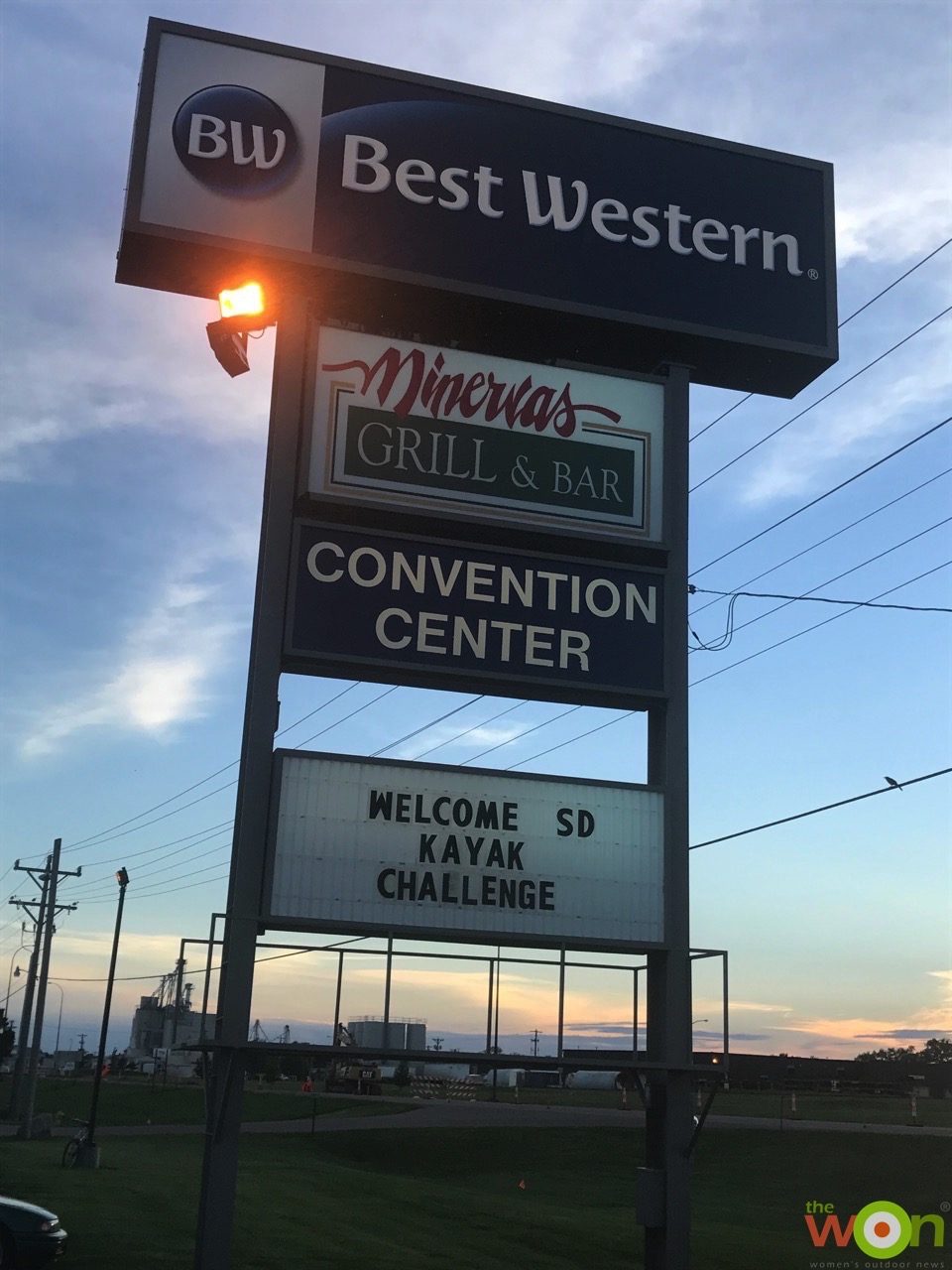
It’s a big deal when the hotel puts your group on their sign.
We settled in for a safety briefing later that evening, where they gave away prizes, and then a free supper. The race organizers worked with the City of Yankton to offer free camping in the park, which held our kayaks overnight – so you could really make this a budget event. (Although we refused to camp overnight and then kayak for 72 miles the following day. I’ll pay $100 for a hotel room, thank you very much.)
The next morning we needed to be at the dock by 6 a.m. for official race start time of 7 a.m. They had 2 categories of racers: competitive and adventure class. Obviously, I was in the adventure class and it seemed the majority of people were with our group. (The total number registered was 180, but many dropped out before the race and during the race this year, which I understand happens every year.)
The competitive class housed sleek, thin, long boats that certainly cost more than $2,000, while our class was a rag-tag of $100 kayaks to $2,000 carbon beauties. I recommend a longer, lighter craft for such a long event, like my Wilderness Pungo 140, or Cassie’s Current Designs 14-footer. For any kayaking adventure more than 4 hours, you need a boat that has 1 or 2 dry hulls, is at least 10 feet or more in length to help navigate the water better, is stable and ideally, lightweight. Although the lighter the kayak, the more expensive it is.
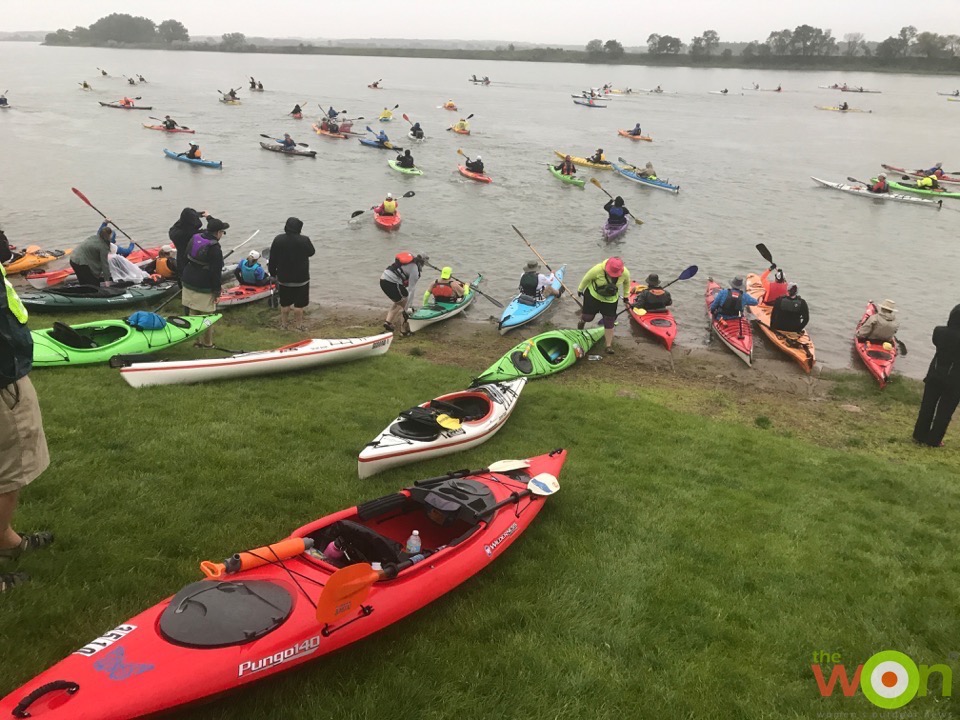
The launch of the South Dakota Kayak Challenge.
Launch
And to add to the fun, it was raining all morning. Small sprinkles at first and then downpour as we settled into our kayaking. Most were NOT prepared for the rain. We later learned many kayakers dropped out at the first checkpoint due to being soaking wet and one lady was diagnosed with hyperthermia! We were disappointed how these groups of kayakers were so unprepared for the weather. Kayaking is one of those activities where you can literally throw in the kitchen sink in the trunk (as your kayak is on top) so you are prepared for anything.
The first 2 checkpoints – located at 18 miles and 12 miles – flew by. After that, it definitely started settling in that we had a LONG ways to go and a short time to get there. Thank goodness my mom was at each checkpoint prepared with sandwiches, water and other fun items to keep caffeine, sugar and protein in our bodies. And thankfully, I brought my UE Boom speaker. Halfway through the race, we turned up the music and jammed out in our kayaks. There’s not much to see on the Missouri River to keep your occupied. Wildlife, yes, but not much for houses on the South Dakota or Nebraska sides of the rivers, nor much for traffic (other boaters). It’s just you navigating the river and trying to follow the current.

A “not too happy” checkpoint because of the rain.
Keep on paddling
We were lucky this year. Heavy rains in May brought the water levels up on the Missouri, which is normally full of sandbars to trap you. And the current was quicker than in years past. I don’t know when we would have finished if we didn’t have those 2 things in our favor. And the wind was in our favor, too. The great Plains is known for wind and I couldn’t imagine fighting that level of wind for 15 hours. Wind can tire you out quicker than anything else when kayaking.
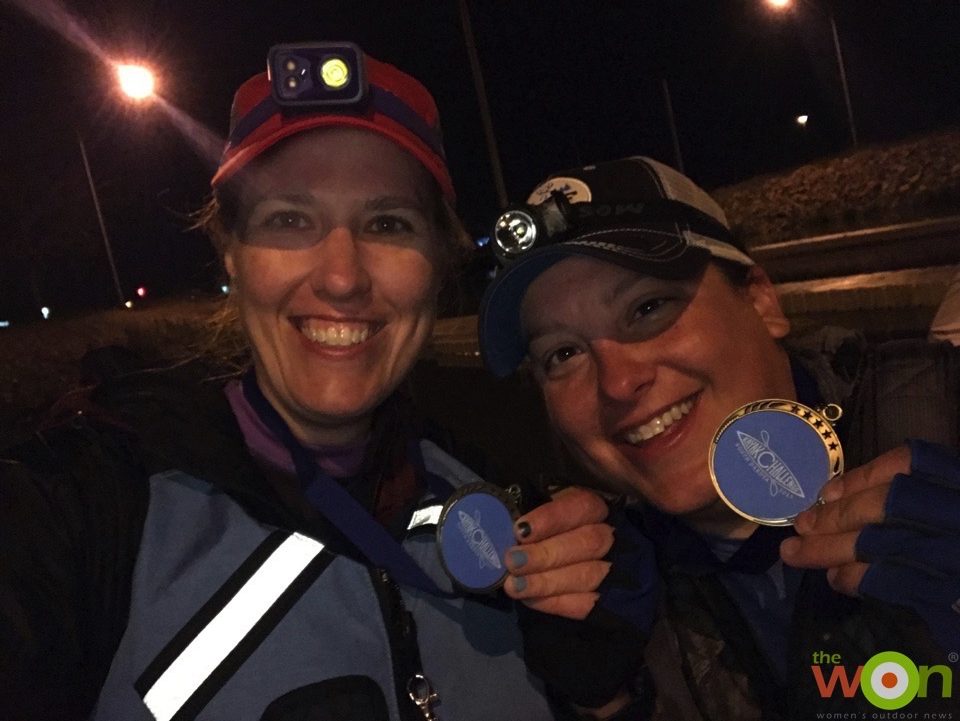
We completed the South Dakota Kayak Challenge!
At the end of the day – and I literally mean the “end” – we had each kayaked more than 15 hours, covered 72 river miles, ate 2 ham sandwiches, 3 protein bars, multiple Oreo cookies, and other snacks. We drank I don’t know how many bottles of water with hydration and energy tabs. I felt like we were eating ALL THE TIME. But yes, we completed the South Dakota Kayak Challenge!
Enjoy the view
Even thought I was the LAST person to cross the finish line, (yes, Cassie beat me), I saw the most beautiful sunset and rainbow from the river. I’ve never seen a rainbow from end-to-end and my pictures don’t do it justice. I had to stop paddling to truly take it in – those who finished hours before us never saw that gift. Everything happens for a reason, folks.
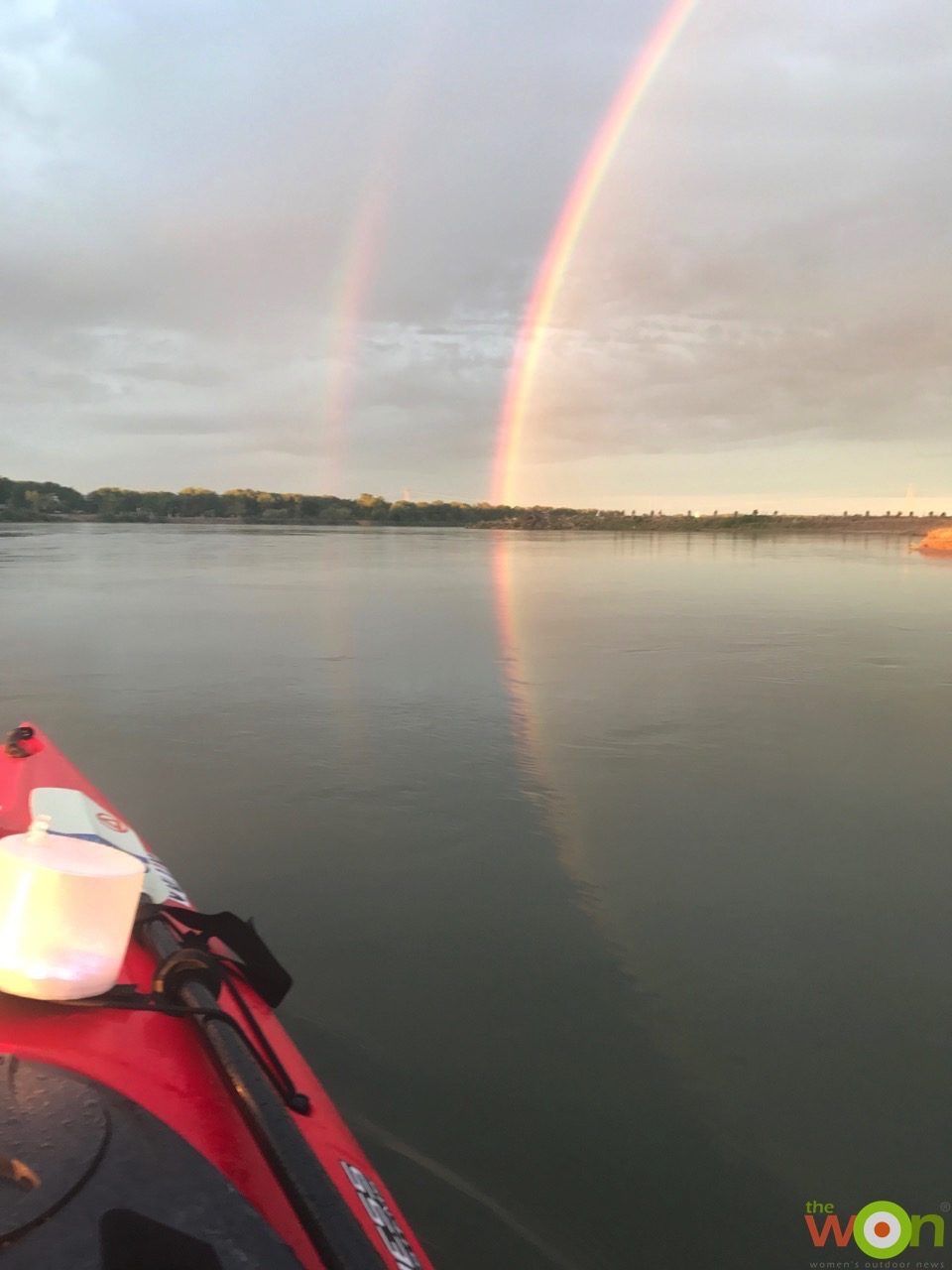
A shout out goes to the City of Yankton Fire & Rescue team, and a special thanks should be delivered to the mayor of Yankton, who flew piloted a plane over us during the first leg of the race to watch us.
The Women's Outdoor News, aka The WON, features news, reviews and stories about women who are shooting, hunting, fishing and actively engaging in outdoor adventure. This publication is for women, by women. View all posts by The WON